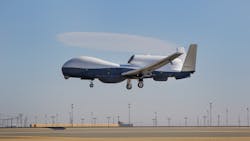Five sobering lessons from Iran's shooting down of America's most capable unmanned aerial vehicle (UAV)
WASHINGTON – Iran's destruction of a U.S. Global Hawk unmanned aerial vehicle (UAV) with a surface-to-air missile near the Strait of Hormuz should be a wake-up call for proponents of autonomous or remotely piloted warfighting systems. Forbes reports. Continue reading original article
The Military & Aerospace Electronics take:
26 June 2019 -- Because it was bigger and costlier than other drones, Global Hawk was designed with a rudimentary ability to defend itself from threats such as laser-guided missiles. But there’s only so much you can squeeze into a 3,000-pound payload capacity, and other features of the aircraft make it a sitting duck.
The weapon used by Iranian forces to down the Global Hawk UAV was an indigenously developed Khordad 3 surface-to-air missile. Khordad 3 is a road-mobile air defense system capable of attacking as many as four targets simultaneously to ranges of 50 miles and altitudes of 90,000 feet -- higher than any U.S. military aircraft flies.
When a second-rate military power shoots down your most capable UAV, the lesson is obvious: the U.S. shouldn’t rely too heavily on unmanned aircraft to carry out its war plans.
Related: Northrop readies SIGINT for MQ-4C Triton UAV
John Keller, chief editor
Military & Aerospace Electronics
